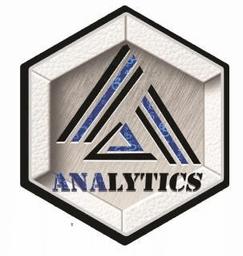ANA ANA ANA YZIA YZIA YZIA









(Marketing & Strategy)
IBS Hyderabad
Associate Professor



(Marketing & Strategy)
IBS Hyderabad
Prof. Madhavi Garikaparthi (Coordinator-Student Activities,) Associate Professor Prof Dr Vaibhav ShekharWe IBS Analytics Club would like to express our sincere gratitude to ICFAI Business School Hyderabad for providing us with an amazing platform to put forward our magazine. As a team, we are highly obliged in taking this opportunity to convey our sincere regard to Prof. Madhavi Gankaparthi Ma’am (coordinator – of student Activities and Associate Professor, Department of Marketing & Strategy) for her constant support and encouragement throughout We are also grateful to Prof Dr Vaibhav Shekhar Sir (Associate Professor, Department of Marketing and strategy) for his immense support and guidance towards the launch of the magazine.
Lastly, we would also like to thank each and every member of our club for working hard with utmost diligence and perfection and supporting each other throughout the course of this magazine
IBS Analytics Club, IBS Hyderabad, a Constituent of IFHE, Deemed University

The Editorial vertical of IBS Analytics Club is proud to present, Analyzia Volume 5.0 Issue 2! The theme of the issue is ‘The Beginnings’, which will take you through the journey, looking back in time along the past few decades, that have seen dramatic changes in the world as we know it.
We present the articles ranging from the history of various market segments to the beginning of collapse of Silicon Valley Bank, penned by our enthusiastic team members, analyzing the beginning of various institutions and the beginning of the end of few institutions

With this new volume, we have introduced a variety of new sections to keep our digital readers engrossed, abreast and intrigued! This includes brain teasers to tickle the grey cells as well as, fun facts, putting analytics into purview.
At IBS Analytics Club, we believe in building a network of nurturing connections. Hence, we welcome your constructive feedback on the magazine, in general or specific. Feel free to reach us at: ibsanalytics.editorials@gmail.com
We hope you enjoy reading as much as we enjoyed making it for you!
The Birth of Stock Market
History of Commodity Trading

Riddles
The Great Depression: Reshaping the Economic Landscape
SVB Collapse - Where it all started?
Fun - Facts
The Literary Queue
A stock exchange, often known as a stock market, is a physical or online location where investors can purchase and sell securities, including stock, in publicly traded corporations. Supply and demand, investor mood, domestic and international economic developments, and supply and demand dynamics influence each share's price. The price rises as more individuals want to purchase shares (or as demand increases). The price of a share decreases when there is less demand Most nations currently have stock markets, but the first was established in Amsterdam in the 17th century.

Ancient civilizations had the idea of trading items Early enterprises would pool their resources to send ships across the ocean to distant countries. Trading organizations or lone traders carried out these transactions for thousands of years. Merchants met in the center of towns throughout the middle Ages to exchange and trade items from many nations Since these traders came from various countries, a money exchange had to be set up to ensure that trades were fair. By the end of the 1400s, Antwerp, or what is now Belgium, became the hub for world trade It is believed that certain business owners would purchase products at a given price in the hopes that the price would increase and allow them to profit. Wealthy merchants would loan money at high-interest rates to others who needed to borrow money. The bonds guaranteed by these loans would then be sold by these merchants, who would pay the buyers' interest.
The Dutch East India Corporation became the first publicly traded corporation, which led to the establishment of the first modern stock trading market in Amsterdam. The business decided to sell stock and give shareholders dividends to obtain funds The Amsterdam stock exchange was subsequently founded in 1611. Shares of the Dutch East India Company were the only securities traded on the exchange for a long time.
At this time, comparable businesses were being founded in other nations, and stock purchases were becoming common among investors Most investors were so enthralled by the enthusiasm that they invested in any startup that became available without researching the company first. Due to the resulting financial instability, investors eventually tried to sell all their shares quickly in 1720 out of panic But nobody was buying, and the market fell The South Sea Bubble was the next financial crisis in England shortly after. Investors grew acclimated to the idea of trading stocks, even though the thought of a market crash worried them.
The U S entered the stock market in the late 1700s, even though the first stock market opened in Amsterdam in 1611. A select group of businesspeople made the Buttonwood Tree Agreement at that time. This group of men regularly got together to trade stocks and bonds, which eventually gave rise to the New York Stock Exchange (NYSE), as it is known today. The Philadelphia Stock Exchange was America's first stock exchange, even though the Buttonwood dealers are credited with creating the country's largest stock market The Philadelphia Stock Exchange, established in 1790, had a significant influence on the city's position in the world economy, contributing to the growth of the financial industry in the United States and its westward spread.
The National Association of Securities Dealers Automated Quotations, or NASDAQ, a second stock market in America, started trading in 1971. In 1992, it teamed up with the London-based International Stock Exchange. This connection created the first international securities market. The NASDAQ allowed investors to trade stocks over a network of computers rather than in person, in contrast to the NYSE, which is a real-world stock exchange. Investors could purchase and sell stocks on the American Stock Exchange or other regional markets, like those in Boston, Philadelphia, and San Francisco, in addition to the NYSE and the NASDAQ It took centuries for the New York Stock Exchange to reach its current state. The Buttonwood traders created the New York Stock and Exchange Board in 1817 after visiting and observing the Philadelphia Merchants Exchange. The members have to enter the exchange and adhere to a dress code Additionally, they had to pay a charge, which by 1837 had gone from $25 to $100. Lower Manhattan lost 700 buildings in the Great Fire 1835, while Wall Street sustained substantial property losses. Fortunately, Samuel Morse established a telegraph demonstration office, enabling remote communication between brokerages. The NYSE opened its doors 1903 with thousands of stock certificates stored in underground vaults.
Despite signs of an economic collapse, the stock market soared and reached a 50% high in 1928. Black Thursday, a day when the market fell 11% in 1929, is referred to as such. Investors panicked as a result of the market decline, and it took the entire 1930s for things to stabilize. The Great Depression was in effect during this time. The market has seen numerous additional disasters since then, including the 2008 subprime mortgage crash

Even though the NYSE was founded by a small group of merchants’ centuries ago, several investors, exchange executives, businesses, and regulators have helped it develop into what it is today. The biggest stock exchange in the world is the NYSE. Nevertheless, domestic and foreign equities are now traded on exchanges in significant cities worldwide. These include the stock exchanges in London and Tokyo. Other major exchanges may be found in China, India, Canada, Germany, France, and South Korea
Author: Priyanshu Goyal

As old as human civilization, commodity dealing was one of the first human endeavors in economics Trading in commodities has developed over the years from the barter system to spot markets to derivatives markets. When using a barter system, two parties with complementary and opposing demands would trade items (for instance, wheat bags were sold for cattle). Over time, goods transported from far-off locations were traded for gold and silver. A paradigm shift in commodity trading occurred with the advent of money as a means of Exchange Now, the worth of commodities was stated in monetary terms, and most commodity trading was done using money. Commodity spot markets developed in various locations, and the counterparties met to exchange items for immediate sale and delivery at the going rate set by supply and demand On spot markets for commodities, dealers offer things like rice for quick delivery in Exchange for money. At some point, counterparties began concluding contracts to provide commodities (such as wheat) at a predetermined future period for a price agreed upon today Such contracts were termed as forward contracts.
For instance, on May 25, a trader decided to sell rice regardless of the actual price in effect on June 25 for delivery on a future date. Due to price fluctuations and market conditions, neither of the contracting parties frequently honored these forward contracts. He rescinded the contract if the spot price was more lucrative for the seller than the agreed-upon price If a buyer could purchase the commodity on the spot market for less money, he would also opt not to execute the contract regarding its maturity. Because the Exchange guaranteed the fulfillment of the contract in the case of futures, they were able to address the issues of counterparty default.

Before the delivery date, contracts started to be traded. For instance, a buyer of a wheat contract can decide he does not need the wheat and instead sell the contract to someone else. The farmer might even transfer his contractual duty to another farmer if he didn't want to provide his wheat. Depending on what transpired in the market, the contract's price would rise, or the wheat industry would be affected
Even others who had no intention of ever purchasing or selling wheat started trading in the futures contracts gradually, hoping to make some money by speculating on their expectations. They were referred to as speculators. They bought contracts intending to eventually sell them for more money than they paid for them. Or, they sold the contracts in advance, planning to purchase them later for less money than they were paid This is how the commodity futures market came to be. By trading in the futures markets, the hedgers (in this case, the commodity producers or farmers) started to effectively transfer their market risk associated with holding physical commodities to these speculators
The Osaka Rice Exchange, established in 1730, was the first established futures market in the history of commodity futures trading. Osaka became the central trading hub for rice in Japan in the 17th century. As the primary agricultural product of the period, rice was significant to the economy. Rice was transported to Osaka and stored there from all around the nation. It was sold through auctions, and after negotiations were completed, the sellers gave buyers a certificate of title in return for payment The documents were known as rice bills. Initially, rice bills were issued after receiving a good faith deposit, which was promptly repaid following the auction along with the delivery of rice. Merchants had the option of keeping the bills or selling them to make a quick profit within the predetermined time. The deposits, however, decreased, and the delivery dates grew longer as the market matured. The rice bills represented the right to accept delivery of a predetermined amount of rice at the current price at a later date This served as the future
In 1848 and 1877, the Chicago Board of Trade (CBOT) in the United States and the London Metal Exchange (LME) in the United Kingdom successfully commenced their operations. In the following few decades, many additional exchanges were established in other nations around the globe, including Argentina, China, Egypt, Russia, Hungary, Turkey, and India Following the 1990s, when markets were liberalized, and information technology grew rapidly, commodity exchanges proliferated worldwide.
The history of trading in commodities in India spans several centuries. The 'Arthasastra' by Kautilya makes mention of markets for the forward trading of metals, agricultural products, and animals As early as 320 B C , words related to business, including "Teji," "Mandi," "Gali," and "Phatak," were created and used openly. However, the Bombay Cotton Trade Association Limited, using cotton as the underlying commodity, began organized trading in commodity derivatives in India in 1875 A few years later, the Gujarati Vyapari Mandali was established and began trading in cotton, cotton seed, and groundnuts. The Calcutta Hessian Exchange was established in 1919 and immediately started trading raw jute and jute products As a result, numerous other commodities derivatives trading hubs popped up throughout the nation in cities like Hapur, Amritsar, Bhatinda, Rajkot, Jaipur, etc.

Various limits were occasionally imposed on trading multiple commodities due to factors including speculation, stockpiling, conflicts, and natural disasters. Bombay Contract Control (War Provision) Act and the Cotton Contracts Board were established by Bombay's government in 1919. The Government of Bombay issued an Ordinance in September 1939 that forbade dealing in cotton options to limit speculative activity in the cotton market. This Ordinance was eventually replaced by the Bombay Options in Cotton Prohibition Act of 1939. The Defence of India Act was created in 1943 to outlaw advanced trade in particular commodities (such as spices, vegetable oils, sugar, cloth, etc.) and regulate it in others across the country Following the expiration of the Defence of India Act, these instructions were kept in place with the appropriate adjustments in the Essential Supplies Temporary Powers Act of 1946. Following Independence, the Indian Constitution added "Stock Exchanges and Futures Market" to the Union List; as a result, the Government of India became responsible for regulating forward contracts. The Parliament created the Forward Transactions Regulation Act in 1952 to control commodity forward transactions across the nation With effect from September 28, 2015, the Securities and Exchange Board of India (SEBI) assumed responsibility for the regulation of the commodity derivatives market following the repeal of the Forward Contracts Regulation Act (FCRA) of 1952 and the Securities Contracts Regulation Act (SCRA) of 1956
Indian exchanges now offer sophisticated commodity trading. For buyers and sellers to better control their price risks and enhance their physical items' marketing, the exchanges provide electronic trading platforms. As a result, the commodity sector is now more productive and aggressive Exchange-traded commodities derivatives have become a popular investment instrument worldwide, employed not only by ordinary investors but also by institutional investors, hedge funds, and sovereign wealth funds. Commodity investments have become increasingly sophisticated with the development of exotic products like weather derivatives, power derivatives, and environmental emissions trading (trading in carbon credits).
Author: Priyanshu GoyalI am a tool that analyzes vast amounts of data, Uncovering patterns and trends, making insights data-led.

I crunch numbers, predict outcomes, and find what's hidden, In the realm of analytics, I am truly driven. What am I?
I am a term that refers to data that's incredibly vast, Too large to be managed by traditional methods of the past.
With velocity, variety, and volume, I thrive, But without proper analytics, I'm just a jumble of data alive. What am I?


I'm the process of visualizing data with finesse, Through charts, graphs, and visuals, I must impress.
I make complex information easier to understand, Unveiling insights in a way that's grand.
What am I?
I'm an important concept, crucial for success, Using historical data to make informed guesses. With regression, classification, and clustering to employ, I help predict outcomes, bringing insights to deploy.

What am I?
I'm a method that involves asking questions of data, Exploring relationships and trends to make sense, you see.
I can be exploratory or descriptive in my approach, Uncovering insights, like a detective, I encroach.
What am I?


The Great Depression, a severe worldwide economic downturn in the 1930s, had a profound and enduring impact on the global economy Its repercussions reshaped economic policies, financial systems, international trade, and social welfare programs worldwide. What happened in the 1920s in the United States and worldwide?
The Great Depression began with the stock market crash on October 29, 1929, known as "Black Tuesday." Speculation and excessive borrowing had driven stock prices to unsustainable levels, leading to a sudden collapse in stock values The crash shattered investor confidence and triggered a chain reaction of economic problems. The stock market crash caused a sharp decline in consumer spending and business investment. This, coupled with a reduction in international trade, led to a contraction in economic activity Businesses faced declining profits and were forced to cut production and lay off workers, leading to widespread unemployment. The financial sector suffered significant losses during the Great Depression. Many banks had invested heavily in the stock market and experienced substantial losses when the market crashed. As a result, numerous banks collapsed, eroding public confidence in the banking system This further exacerbated the economic downturn as people lost their savings and credit froze. The overproduction of goods during the 1920s, particularly in the agricultural and manufacturing sectors, led to excess supply. However, with declining incomes and widespread unemployment, people needed more purchasing power, resulting in under-consumption. This created a reduced production cycle, further layoffs, and decreased demand. The Great Depression was not limited to the United States; it had a global impact Countries relied heavily on international trade, and when the U S economy faltered, it led to a decline in global trade. Protectionist measures, such as tariffs and trade barriers, worsened the situation by reducing international commerce and exacerbating economic difficulties

It had profound social consequences Unemployment rates soared, poverty levels rose, and people faced extreme hardships. Homelessness, hunger, and destitution became widespread. Many individuals and families lost their homes and were forced into makeshift shantytowns, while others relied on government relief programs or charitable assistance.
The current global economy has a lot to learn from the great depression; some of the major learnings were-
Ø Interconnectedness: The current global economy is distinguished by unprecedented interconnectedness across nations The Great Depression emphasized the dangers of isolationism and protectionist policies, prompting a shift towards more international collaboration and commerce. Countries see the value of interconnection and work to achieve global economic stability through organizations such as the World Trade Organisation (WTO) and regional trade agreements.

Ø Keynesian Economics: The Great Depression also influenced economic thought and paved the way for the rise of Keynesian economics British economist John Maynard Keynes argued that during times of economic downturn, governments should increase spending to stimulate demand and counteract recessions. This idea shaped economic policies in subsequent decades and contributed to accepting fiscal stimulus as a tool to manage economic fluctuations.
Ø Government Intervention and Regulation: The Great Depression exposed the limitations of laissez-faire economics and precipitated a paradigm shift towards more government intervention. Governments increasingly take a more active role in economic management, enacting fiscal and monetary policies to stabilize and boost development Financial institution regulations and consumer protection have been improved to avoid a repetition of the 1930s financial catastrophe.
Ø Global Financial Institutions: The Great Depression exposed flaws in the international financial system and led to the establishment of global financial institutions to promote stability and cooperation. The International Monetary Fund (IMF) and the World Bank were created after the Great Depression to provide financial assistance, facilitate international monetary collaboration, and support economic development. These institutions continue to play a significant role in the present world economy.
Ø Trade and Protectionism: The Great Depression triggered a wave of protectionist measures as countries sought to safeguard their domestic industries and protect jobs. However, the negative consequences of this approach became apparent, leading to a recognition of the benefits of international trade and economic cooperation Over time, efforts were made to reduce trade barriers, forming institutions like the World Trade Organization (WTO) and the proliferation of regional trade agreements. These developments shaped the present global trade landscape.
Ø Macroeconomic Management: The Great Depression highlighted the importance of macroeconomic management and the need for governments to use monetary and fiscal policies to stabilize economies actively. Central banks and governments now closely monitor economic indicators, implement counter-cyclical measures, and adjust interest rates and taxation to manage economic fluctuations. This approach to macroeconomic management, influenced by the lessons of the Great Depression, remains a crucial aspect of the present world economy.
Ø Social Welfare and Safety Nets: The Great Depression's hardship and social instability prompted the foundation of social assistance programs Governments established safety nets, unemployment programs, and healthcare systems to safeguard residents during economic downturns. These programs seek to eliminate inequality and assist those in need, contributing to social stability
Ø Global Financial Institutions: The Great Depression exposed the vulnerabilities of the global financial system. In response, international financial institutions such as the International Monetary Fund (IMF) and the World Bank were created to provide financial stability, promote economic development, and assist countries in times of crisis. These institutions serve as vital pillars of the present global economic architecture.
Ø Technological Advancements and Globalization: Technological advancements have significantly transformed the present global economy. Innovations in communication, transportation, and manufacturing have facilitated the rapid expansion of worldwide trade and the integration of markets. Information and communication technologies have allowed businesses to operate across borders more efficiently, promoting globalization and economic growth

The Great Depression is a stark reminder of the dangers of unregulated markets, excessive speculation, and income inequality Governments and central banks now employ macroeconomic policies to mitigate these risks and maintain stability. The importance of international cooperation, sound regulation, and financial safeguards has been ingrained in the global economic framework
Author: Vishal Verma16th largest bank in the US. Once seen as a significant tech banking player, SVB's stunning collapse spurred other bank closures, rattled global markets, and threatened the livelihoods of start-ups across the country. SVB opened in 1983 to serve fledgling tech companies. Eventually, nearly half of the country's venture capital-backed technology and life sciences companies would rely on SVB Roku, ROBLOX, and many others put millions into the bank, helping SVB become one of the nation's largest. These are companies that move quickly, and their money moves rapidly. They promptly moved their money out of the bank when things went off the rails

After the banking crisis that triggered the Great Recession, President Barack Obama signed the Dodd-Frank Act, making banks like SVB face stricter regulation. It is designed to ensure that everybody follows the same rules. But eight years later, during the Trump administration, some of those regulations on smaller banks were rolled back Some rules were moved back for these banks with less than $250 billion in assets. SVB was flooded with cash two years later as businesses deposited more during the pandemic. Deposits tripled to $189 billion in two years, making 2021 SVB the most profitable year ever. So SVB Financial took that cash and bought tens of billions of dollars of longerterm US treasuries and government-backed mortgage securities.
After SVB had stockpiled that hundred billion dollars plus in bonds, interest rates rose suddenly. Banks, including SVB holding many bonds, were sitting on many losses. And so all of a sudden, the gap between what SVB had paid for those bonds and what they were worth on paper had jumped to more than $17 billion, and that was the critical risk that would eventually lead to SVB's undoing.
The bank's deposits were held in 37,000 accounts with over $250,000 The amount insured by the FDIC. Then in a regulatory filing on March 8th, SVB announced it sold a large chunk of securities at a loss of about $1.8 billion to help cover that decline in deposits.
The stock fell a tremendous amount, which is never a good sign. Crypto-focused bank Silvergate had just announced it would wind down and return all warranties Start-up CEOs began receiving urgent calls from panicked venture capital investors. As word spread across the valley, what started as a trickle of withdrawals quickly became a tidal wave More and more start-ups pulled their cash The bank's stock price fell the next day as customers tried to withdraw $42 billion in deposits. SVB ran out of cash. The bank has enough money to cover deposits if they come out peacefully and orderly. When everyone's racing for the exits at once, it doesn't That day, regulators seized the bank But the bank had over $151 billion in deposits that weren't insured at the end of 2022. They were over the $250,000 limit.

SVB's focus on Silicon Valley made it uniquely vulnerable to a run. Its fortunes were tied to the fortunes of this one industry. But what's more, this is an industry that has flighty deposits One can't rely on short-term funding to support these long-term investments and bonds. With investigations into SVB underway, the bank's clients will see their money returned. But shareholders are still looking for a way to get through.
Author: Bhargavi SiramThe demand for skilled analytics professionals is on the rise. According to the World Economic Forum, by 2025, the world will need 150 million more data analysts to meet the growing demand for data-driven insights.
The field of analytics has been around for centuries. The ancient Egyptians used analytics to track crop yields, while in the 19th century, Florence Nightingale used statistical analytics to advocate for improved healthcare practices during the Crimean War.



The term "analytics" is derived from the Greek word "analytikos," which means "breaking up" or "loosening." It reflects the process of breaking down complex data sets to gain insights and make informed decisions.


Analytics is not limited to business applications. It is widely used in sports to analyze player performance, develop game strategies, and make informed decisions about team management and recruitment.
the term "big data" refers to extremely large and complex data sets that cannot be easily managed or analyzed using traditional data processing methods. The term gained popularity in the early 2000s as the volume, velocity, and variety of data grew exponentially.




The concept of data visualization plays a crucial role in analytics. By presenting data in visual formats such as charts, graphs, and infographics, analysts can communicate complex information more effectively and uncover patterns and trends that may not be apparent in raw data.

Analytics has transformed industries such as marketing, finance, healthcare, and transportation. It has enabled businesses to optimize their operations, improve customer experiences, identify market trends, detect fraud, and make data-driven decisions for growth and innovation.
The demand for skilled analytics professionals is on the rise. According to the World Economic Forum, by 2025, the world will need 150 million more data analysts to meet the growing demand for data-driven insights.
Analytics is a constantly evolving field. As new technologies and methodologies emerge, analytics continues to push the boundaries of what is possible, unlocking new opportunities for businesses, researchers, and decisionmakers.





"The Circle" by Dave Eggers: This dystopian novel explores the dark side of a powerful technology company that aims to connect all aspects of people's lives, blurring the boundaries between privacy, surveillance, and data analytics.

"Super Sad True Love Story" by Gary Shteyngart: Set in a near-future where technology and data analytics dominate society, this satirical novel follows the love story of two individuals amidst a world obsessed with personal data and social media.

"The Informationist" by Taylor Stevens: This thriller follows the story of an information specialist who combines her analytical skills with her past to unravel a dangerous mystery involving a missing girl in Africa.

"The Travelling Cat Chronicles" by Hiro Arikawa: While not directly related to analytics, this heartwarming novel tells the story of a stray cat and his owner as they embark on a journey together, highlighting the power of relationships and the value of human connections."

"The Age of Miracles" by Karen Thompson Walker: In this coming-of-age tale, the protagonist faces the challenge of adjusting to a world where the rotation of the Earth starts to slow down, causing disruptions in society and raising questions about adaptation and the use of data.

"The Enigma of Reason" by Hugo Mercier and Dan Sperber: Although not a novel, this non-fiction work explores the flaws in human reasoning and decisionmaking processes, shedding light on how cognitive biases and social dynamics can affect the interpretation and analysis of data.

Priyanshu Goyal
Bhargavi Siram
Jagnoor Kaur
Naincy Nayyar
Shivani Sharma
Vishal Verma
Ekansh Dhingra

Send your feedback articles to IBS Hyderabad, The ICFAI Foundation for Higher Education (Declared as Deemed University U/s 3 of the UGC Act 1956) Donthanapally, Shankarpally, Road, Hyderabad-501203.
Feel free to write back at: editorial.ibsanalytics@gmail.com

Frequency of the Magazine
This magazine is biannual and published twice a year, with support from IBS Hyderabad, a Constituent of IFHE, and Deemed to be University.
Disclaimer
The views expressed by the contributors represent their personal views and not necessarily the views of their organization. All efforts are made to ensure that the published information is correct. The organization is not responsible for any errors caused due to oversight or otherwise.
Copyright
All rights reserved. No part of this publication may be reproduced or copied in any form by any means without prior written permission.
Publisher
Student Club IBS Analytics, IBS Hyderabad, a Constituent of IFHE, Deemed University.

"Analytics is not about finding the right answer; it's about "Analytics is not about finding the right answer; it's about asking the right questions at the beginning." asking the right questions at the beginning."

